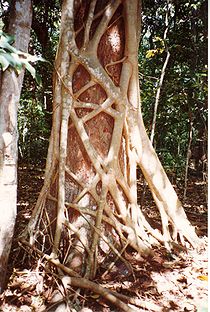
Strangler Fig
Encyclopedia

Banyan
A banyan is a fig that starts its life as an epiphyte when its seeds germinate in the cracks and crevices on a host tree...
s and unrelated vines, including among many other species:
- Ficus aureaFicus aureaFicus aurea, commonly known as the Florida strangler fig , golden fig, or higuerón, is a tree in the family Moraceae that is native to the U.S. state of Florida, the northern and western Caribbean, southern Mexico and Central America south to Panama...
, also known as the Florida Strangler Fig - Ficus barbata, also known as the Bearded Fig
- Ficus watkinsianaFicus watkinsianaFicus watkinsiana, commonly known as Strangler fig, Watkins' fig, Nipple fig or the Green-leaved Moreton Bay Fig is a hemiepiphytic fig that is endemic to Australia...
- Ficus obliquaFicus obliquaFicus obliqua, commonly known as the Small-leaved Fig, a tree in the family Moraceae native to eastern Australia. It is a banyan of the genus Ficus which contains around 750 species worldwide in warm climates, including the edible fig...
- Ficus benghalensisFicus benghalensisFicus benghalensis, the banyan, is a large and extensive growing tree of the Indian subcontinent. Ficus benghalensis produces propagating roots which grow downwards as aerial roots. Once these roots reach the ground, they grow into woody trunks that can become indistinguishable from the main...
They all share a common "strangling" growth habit that is found in many tropical forest species, particularly of the genus Ficus
Ficus
Ficus is a genus of about 850 species of woody trees, shrubs, vines, epiphytes, and hemiepiphyte in the family Moraceae. Collectively known as fig trees or figs, they are native throughout the tropics with a few species extending into the semi-warm temperate zone. The Common Fig Ficus is a genus of...
. This growth habit is an adaptation for growing in dark forest
Forest
A forest, also referred to as a wood or the woods, is an area with a high density of trees. As with cities, depending where you are in the world, what is considered a forest may vary significantly in size and have various classification according to how and what of the forest is composed...
s where the competition for light is intense. These plants begin life as epiphyte
Epiphyte
An epiphyte is a plant that grows upon another plant non-parasitically or sometimes upon some other object , derives its moisture and nutrients from the air and rain and sometimes from debris accumulating around it, and is found in the temperate zone and in the...
s, when their seed
Seed
A seed is a small embryonic plant enclosed in a covering called the seed coat, usually with some stored food. It is the product of the ripened ovule of gymnosperm and angiosperm plants which occurs after fertilization and some growth within the mother plant...
s, often bird-dispersed
Seed dispersal
Seed dispersal is the movement or transport of seeds away from the parent plant. Plants have limited mobility and consequently rely upon a variety of dispersal vectors to transport their propagules, including both abiotic and biotic vectors. Seeds can be dispersed away from the parent plant...
, germinate
Germination
Germination is the process in which a plant or fungus emerges from a seed or spore, respectively, and begins growth. The most common example of germination is the sprouting of a seedling from a seed of an angiosperm or gymnosperm. However the growth of a sporeling from a spore, for example the...
in crevices atop other trees. These seedlings grow their roots downward and envelop the host tree while also growing upward to reach into the sunlight zone above the canopy.
An original support tree can sometimes die, so that the strangler fig becomes a "columnar tree" with a hollow central core.
External links
- The Tropical Rain Forest, including photos of strangler figs
- The Queen of Trees: Fig Trees—From the Sacred to the Strangler
- Strangler figs in MeghalayaMeghalayaMeghalaya is a state in north-eastern India. The word "Meghalaya" literally means the Abode of Clouds in Sanskrit and other Indic languages. Meghalaya is a hilly strip in the eastern part of the country about 300 km long and 100 km wide, with a total area of about 8,700 sq mi . The...
made into "living bridges"

